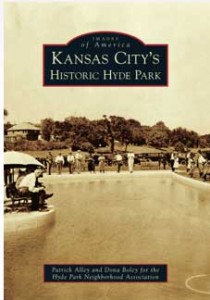
Review by Mark Dillon excerpted from the Hyde Parker newsletter
One gets a sense of the passion that KCMO baby boomers had back in the early 1970s in the final chapter of Kansas City’s Historic Hyde Park. First time authors Pat Alley and Don Boley recount the birth of the modern Hyde Park Neighborhood Association, and how their ambitious generation overcame redlining realtors and road-blocks to rebuild the residential heart of a city.
With help from more than two-dozen neighbors and friends, Pat, 66, a financial advisor with offices on the Country Club Plaza, and Boley, a tireless public advocate for city parks, have pooled four decades of knowledge and experience into a new 128-page, 200 photo-filled book from Arcadia Publishing Co. It looks back in time at both our brick and mortar heritage and cultural roots.
“We complemented each other,” Alley says of a two-year project that began with a phone call when he served as HPNA’s historian. Dona’s extensive contacts with groups such as the KC Parks & Recreation Dept. and the Historic Kansas City Foundation combine with Pat’s writing to provide both a” glimpse into family life a century ago” and a neighborhood memoir.
Overall, the most thoroughly researched element of the book is the story of 180 years of boom and bust, from the Western frontier trail stop of Westport to Gilded Age glory, from 1960s urban blight to rebirth and gradual renewal over the past 30 years. Throughout the work, there’s lavish coverage of our neighborhood’s architectural diversity, from signature properties on Janssen Place to less well-known homes such a rare pre-1890 homestead-style home at 4022 Holmes in South Hyde Park.
“Families who built these homes must have had a great sense of accomplishment at having come very far in a generation,” Alley said. “These were, by and large, people who grew up as farmers without electric lights, who used outhouses.” He also found that even though many Hyde Parkers a century ago faced a lot of personal tragedy and illness, they over-came death of spouses and children and hard times to build a strong community.
Many Hyde Park homes were built prior to World War I, with the biggest construction boom coming between 1890 and 1912 as Kansas City annexed Westport. During that age of exuberance, the authors document that in 1910 former President Theodore Roosevelt visited a then 3-year-old Westport High School to share what the student newspaper said were “hair-raising stories of Africa” from a safari he took the year before. The authors add that Teddy’s friend John Barber White designed the house at 616 E. 36th St. after Roosevelt’s home on Long Island.
One fascinating fact is that the Hyde Park group was originally born as a community protest against higher density zoning in 1924. The association lost that initial battle to the Pendergast political machine, and overbuilding of high rises resulted.